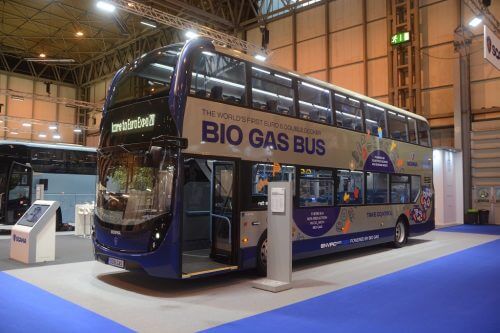
Vehicle being examined as a potential option to satisfy future Clean Air Zone in Leeds
Arriva Yorkshire last week announced the beginning of a month-long trial of Scania’s biogas-powered double decker.
The vehicle took to the streets of Castleford and Leeds on Monday, February 12, running the 163/166 route.
Scania developed the bus over a two year period, working alongside bodybuilder Alexander Dennis Limited (ADL), specifically for the UK market.
Based on an N280UD4x2EB chassis, the Enviro 400-bodied vehicle is powered by Scania’s OC09 101 9.0l, five-cylinder, Euro 6 dedicated gas engine mated to a ZF EcoLife six-speed automatic gearbox.
The power unit develops 280hp at 1,900rpm and 1,350Nm torque at 1,000-1,400 rpm, and can be run on either compressed natural gas (CNG) or biogas.
The biogas fuel – comprised of gases produced by anaerobic digestion of food waste and sewage – enables CO2 emissions to be slashed by 84% compared to an equivalent Euro 5 diesel bus.
Passengers can also utilise onboard WiFi and USB charging points, with next-stop audio announcements assisting new users of the service.
With the advent of Clean Air Zones, Arriva Yorkshire is trialling the bus as a potential solution for reducing emissions.
Pressure is also mounting on operators to reduce CO2 emissions by 80% by 2050 in line with Government plans.
Jon Croxford, Area Managing Director at Arriva Yorkshire, commented: “We are delighted to have partnered with Scania to showcase what is set to be the future of bus travel.
“Here at Arriva Yorkshire we are committed to reducing our environmental impact.
“Trialling new low-emission technologies helps us in moving towards reaching our ambitious group-wide target of reducing our CO2 emissions by 30% by 2020 as part of our Destination Green programme.”
Mark Oliver, UK Bus & Coach Fleet Sales General Manager for Scania, added: “Unlike mainland Europe, British bus networks use a high proportion of double-deck buses.
“Across Europe single deck buses with gas tanks on the roof are a common sight, but for the UK we have had to accommodate the tanks within the double-deck bodywork itself.”

